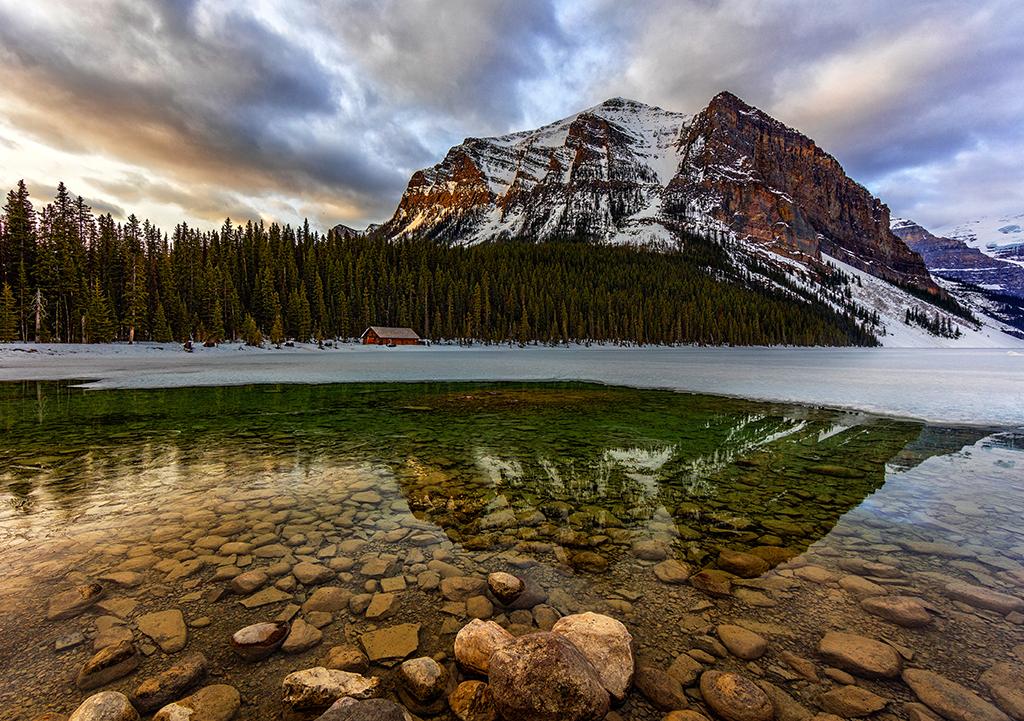
A springtime sunrise over Fairview Mountain and Lake Louise, Banff National Park / Rebecca Latson
In December 2019, February 2020, and May 2020, I wrote pieces regarding my favorite places for photography. For this month’s article, I thought I’d add the final few national park favorite spots I’d like to share with you. These favorite spots are sites I would return to, time and again, under different weather conditions and during different seasons and times of day. And, just in case you’ve been keeping count, I’ve visited more parks than what you’ve seen in these articles. Some of the parks I left out because I’d seen them during a pre-digital camera period of my life. Other parks, like Katmai National Park & Preserve, restricted me to specific locations such as the viewing platforms for bear photography. I could have taken a tour of the Valley of Ten Thousand Smokes, but for me, it was all about the bears. I also left out my trip to Denali National Park & Preserve, where my photo stops were predicated by where the bus stopped. I’m sticking here with national parks which I’ve not only digitally photographed, but which have also allowed me plenty of wandering space.
Hawai’i Volcanoes National Park, on the Big Island of Hawaii
I’m certain the 2018 eruptions have altered the landscape of this national park since my October 2014 and February 2017 visits, but I’ll still list my favorite locations on the off chance they are accessible today.
My very favorite spot in this park was the Kilauea Iki Trail. It’s not so much a single spot, as it is a 4-mile traverse through a lush rainforest with every shade of green, then out over jagged chunks of cooled ‘a’a lava before reaching the broad floor of a solidified lava lake. It was a pretty cool feeling to think I was literally walking on what once was a roiling, searing lake of molten rock!

A wide-angle view of Kilauea Iki, Hawai'i Volcanoes National Park / Rebecca Latson
While there are several places to join the trail, I took the trailhead at the Kilauea Iki Overlook, where I could see teeny tiny people walking along the trail far below. Looking beyond to the other side, I could view the cinder-and-spatter cone Pu’u Pua’i ("gushing hill"), the reddish-brown cavity of which was the main vent for the lava eruption. This overlook makes a great spot for wide-angle shots as well as telephoto close-ups of Pu’u Pua’i and Halema’uma’u Crater beyond.

A telephoto view of Pu'u Pua'i and Halema'uma'u Crater beyond, Hawai'i Volcanoes National Park / Rebecca Latson
During my hike through the rain forest, I captured leading line images of the trail and close-ups of the brilliant green ferns and kahili ginger blooms (an invasive species, unfortunately). I photographed the bright red ohi’a lehua flowers against the grey/black of the solidified lava. They made a great contrast between vibrant life and stony rock. Of course, I also took photos of the wide expanse of the solidified lake, the trail across which is marked with rock ahu (cairns).
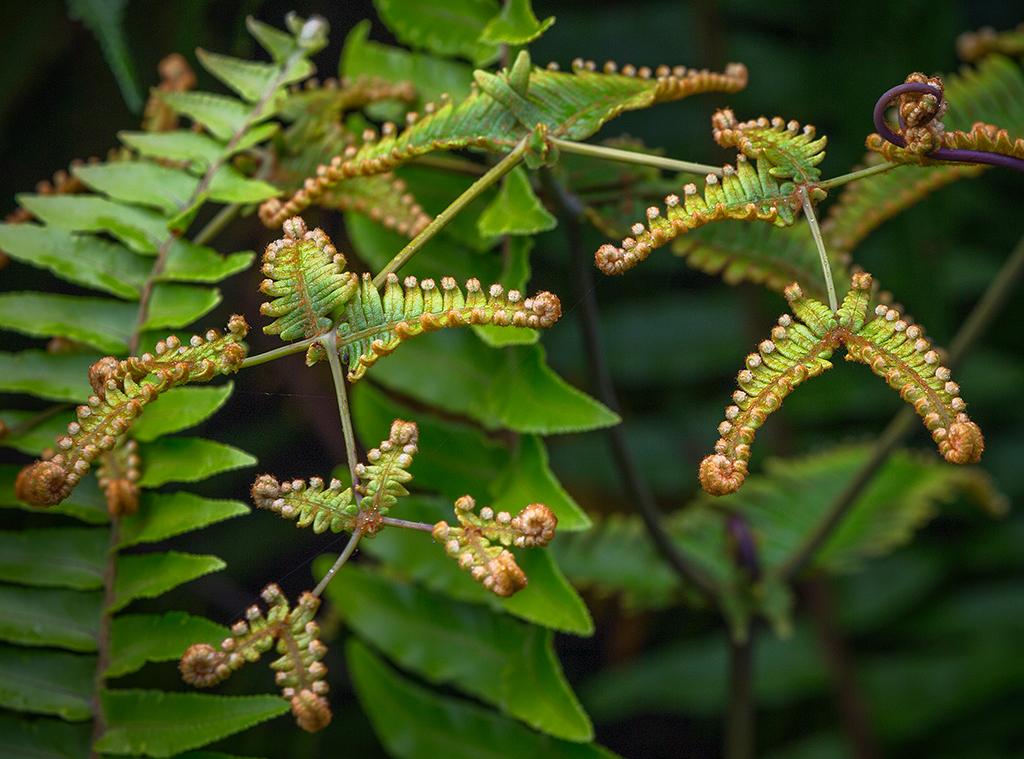
Fern curlicues along the Kilauea Iki Trail, Hawai'i Volcanoes National Park / Rebecca Latson
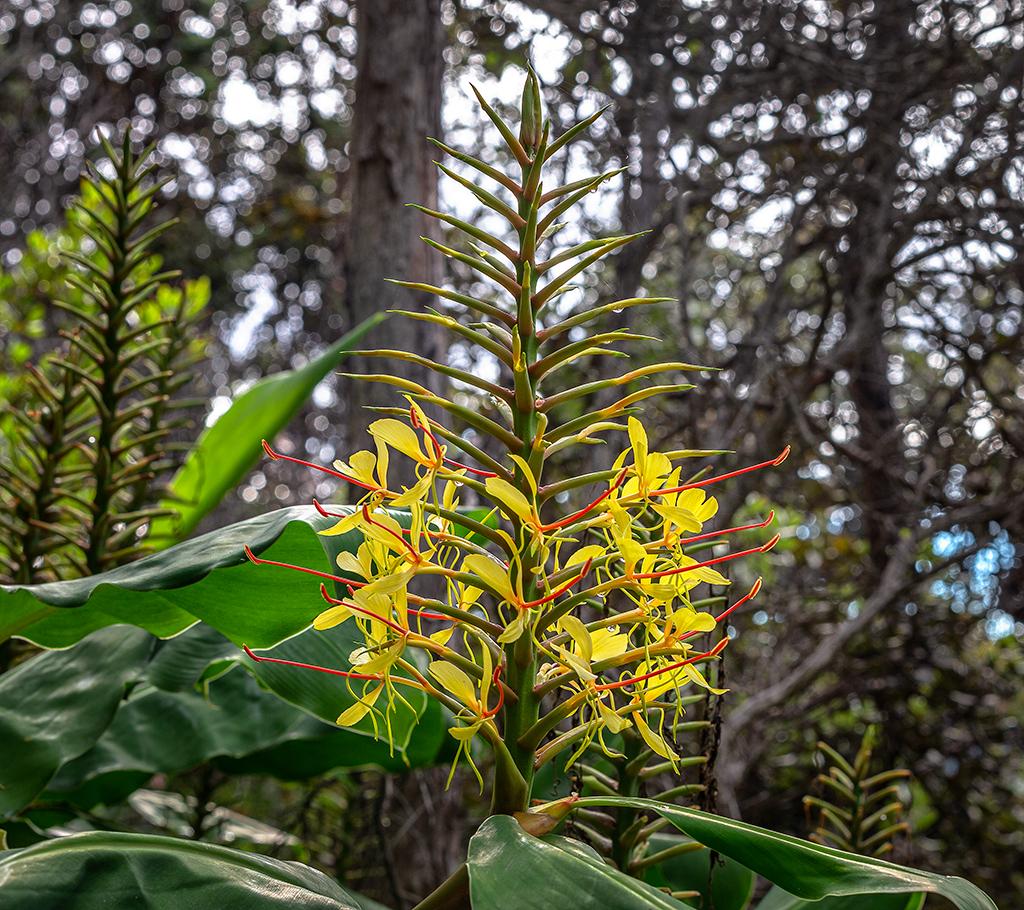
Kahili ginger along the Kilauea Iki Trail, Hawai'i Volcanoes National Park / Rebecca Latson

Ohia amidst the 'a'a on the Kilauea Iki Trail, Hawai'i Volcanoes National Park / Rebecca Latson
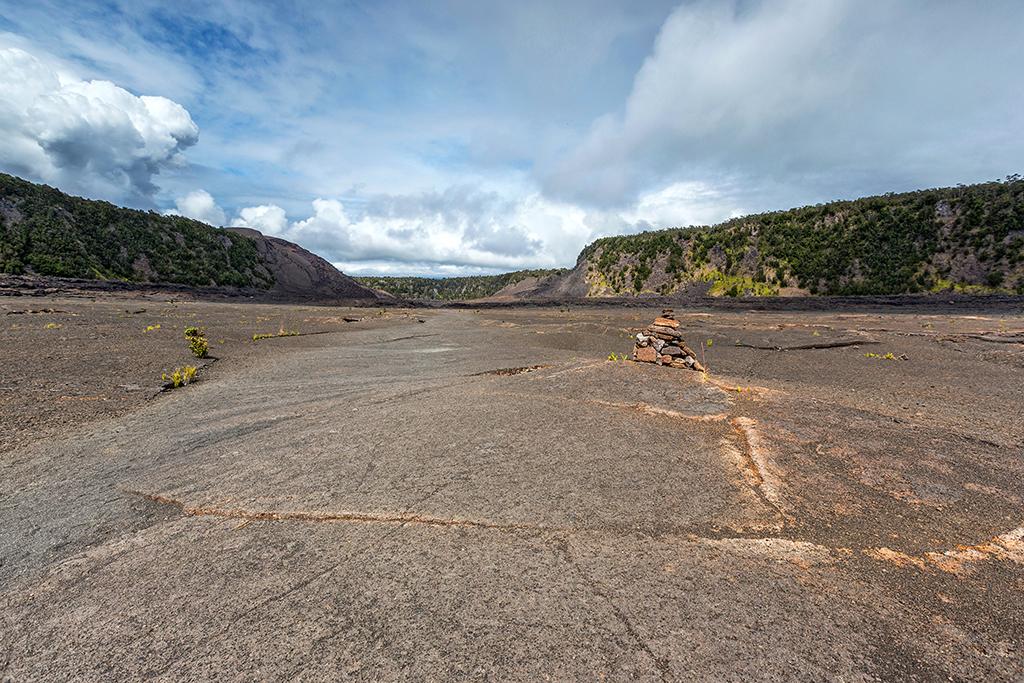
Ahu (cairns) on the lava lake (solidified), Kilauea Iki Trail, Hawai'i Volcanoes National Park / Rebecca Latson
Jaggar Museum was another favorite. It was as close as I could get to Halema’uma’u Crater within Kilauea Caldera. During the day, I shared the overlook with other crowds, but late at night into the wee hours of the morning, it was just me, myself, and I.

The glow of Halema'uma'u Crater, Hawai'i Volcanoes National Park / Rebecca Latson
One more favorite spot was along the Chain of Craters Road. There are several Mauna Ulu lava flows dating from 1969 – 1974. This broad expanse of pahoehoe lava looks just like molten gold in the sunlight, I’m not kidding.
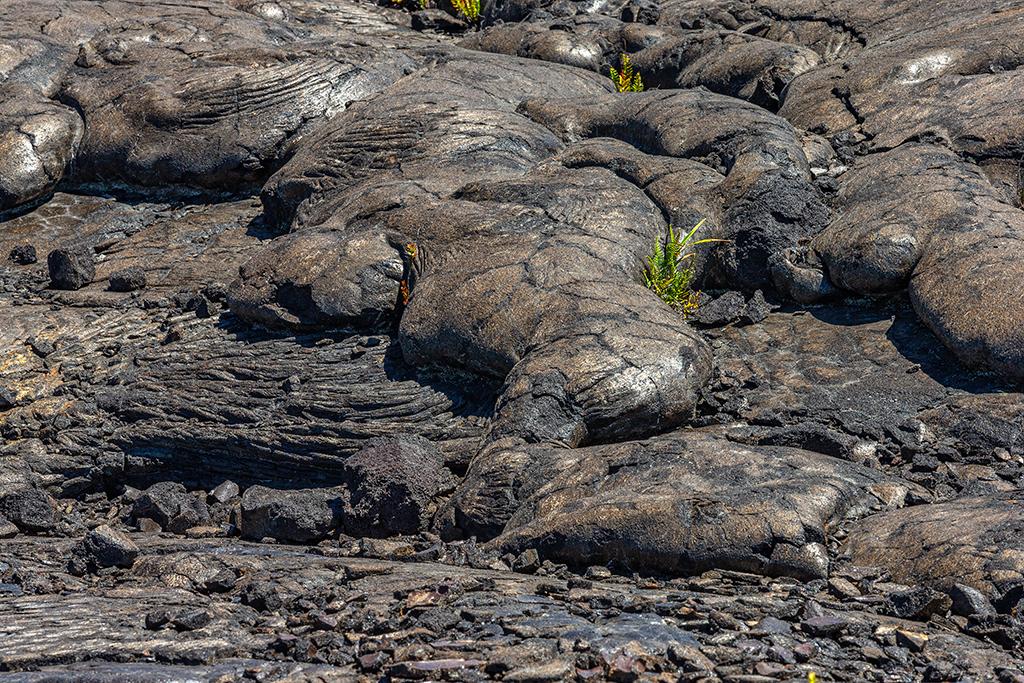
"Golden" pahoehoe along the Chain of Craters Road, Hawai'i Volcanoes National Park / Rebecca Latson
Grand Canyon National Park, in Arizona
The first time I ever visited the Grand Canyon, I was about 3 years old, and I never got to see the grand vistas because my mother, afraid I’d fall into the abyss, held onto my little hand with a grip of iron and kept me far from the edge. Fast forward some 56 years and I can tell you I have visited both the North and South rims, with favorite spots on each.
South Rim
I first visited the South Rim in mid-November. While there were still plenty of tour buses making all the stops, those buses only stayed about 15 minutes per stop, and other crowds usually cleared out by 5 p.m. every day. Early mornings and late afternoons made for perfect photo ops. Because of the season and elevation, I experienced weather ranging from clear sunny days, to sunny, puffy-cloud days, to rain and snow, all of which added to the mind-blowing vastness of this “hole in the ground.” Early mornings and late afternoons were also conducive to good lighting. Anytime after 8:00 a.m. brought a blue haze to the entire canyon scene which didn't diminish until about 4:00 p.m.
Truthfully, every overlook along the South Rim affords stunning images, but I think my favorite spots are Pima Point and Hopi Point. Why those places? Probably for no other reason than my memory of the serendipitous shots I got at the time. I captured a dramatic rainstorm at Pima Point, and at Hopi Point, the clouds in the brilliant blue sky were incredibly puffy, throwing shadows between the sunlight onto portions of the canyon scenery.
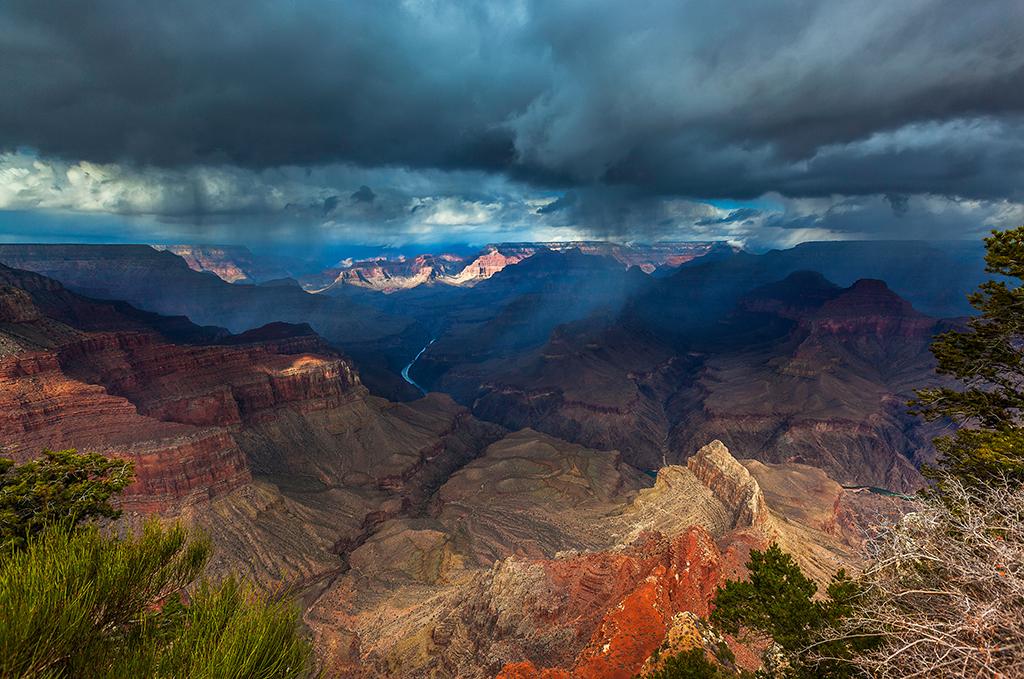
Pima Point autumn thunderstorm, South Rim, Grand Canyon National Park / Rebecca Latson

A midday view at Hopi Point, South Rim, Grand Canyon National Park / Rebecca Latson
North Rim
Believe it or not, of the few hikes I managed during my short 2-1/2-day July stay on the North Rim, my very favorite spots for photography, both morning and afternoon, were at the two, small, fenced-in overlooks right below the Grand Canyon Lodge. It takes a little careful maneuvering over uneven ground to reach these overlooks. Don’t wear flip flops like I saw one guy wearing as he gingerly made his way down to where I stood. Sunrise and sunset imagery were fantastic and I lucked out as a summer monsoon rain drifted across my camera’s composition, with dramatic clouds and a rain veil against an otherwise deep blue sky.

One heck of a North Rim view, Grand Canyon National Park / Rebecca Latson
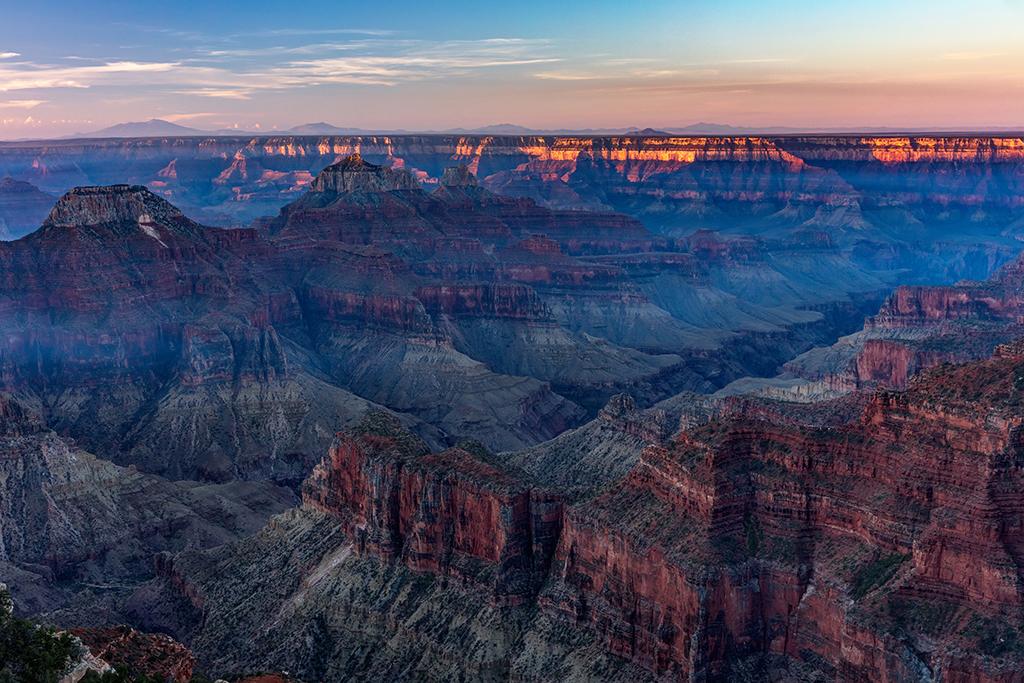
Sunrise over the North Rim, Grand Canyon National Park / Rebecca Latson

An afternoon monsoon over the North Rim, Grand Canyon National Park / Rebecca Latson
Banff and Jasper national parks, Canada
I’m a mountain gal, as I’ve mentioned before (numerous times). I was born in northwest Montana, just a hop and skip from Canada’s Banff and Jasper national parks. I vaguely remember traveling to Banff when I was about 6 or 7 years old, with no camera in hand. Forty-eight years later, I decided an April trip would remedy that situation. First thing you should know about spring in the Canadian Rockies is that there is still plenty of snow, with more snow falling on any given day. It’s a reminder to drive those icy roads carefully and remember to pack your snowshoes.
Of all the locations visited inside Banff National Park and at the edge of Jasper National Park, my two favorite spots I returned to more than once were Lake Louise and the Athabasca Glacier. Lake Louise was sort of a no-brainer since I splurged and lodged at the Fairmont Chateau Lake Louise.
Most of the lake water was still iced over, but portions along the shoreline were thawed, revealing mirror-smooth liquid in the morning and evening upon which reflected those fabulous rugged peaks surrounding the lake. Morning and evening light are the best. The angle of the sun during those times produces light and shadows for drama and depth and awesome photography.

Sunrise reflections at Lake Louise, Banff National Park / Rebecca Latson
Athabasca Glacier, one of 6 “toes” of the Columbia Icefield, is quite the impressive sight, as are the mountains leading up to and on either side of the glacier. Spring snow and sun made the landscape very bright, so I utilized my circular polarizer to reduce glare and keep that white breadth of snow and ice from “blowing out” (overexposing). This is another great place for both wide-angle and telephoto shots. The telephotos help you zoom in on the glacial features, while the wide-angle images give you a sense of scale, especially if you include the tiny dots of people standing on the glacier.

Athabasca Glacier, Jasper National Park / Rebecca Latson

Icefield Parkway scenery, Jasper National Park / Rebecca Latson
Mesa Verde National Park, in Colorado
Most landscape photographers don’t care much for humans or human-made objects in their images. At Mesa Verde National Park, though, it’s all about the architecture and culture of the humans known as Ancestral Puebloans. You can capture wonderful images at this park, and it’s the architecture that really makes the shot. I visited in August, which one would think is a busy, crowded time of year, but I can't really remember any huge crowds during my stay. I would imagine things have changed in terms of visitation since that time.
Cliff Palace is, of course, one of my favorite spots. If you ever visit and can take a guided twilight tour of Cliff Palace, I urge you to do so. You’ll capture some lovely evening shots, as the sun shines at an angle against the ruins, saturating the pink-ish stone with a golden hue. I lugged a tripod with me, but in retrospect, I would advise against a tripod unless you can carry it attached to your backpack. This is one of those places where handholding the camera is easier. Because of the fading light, I needed to bump up my ISO and slow my shutter speed. Lens or in-camera vibration reduction comes in handy.
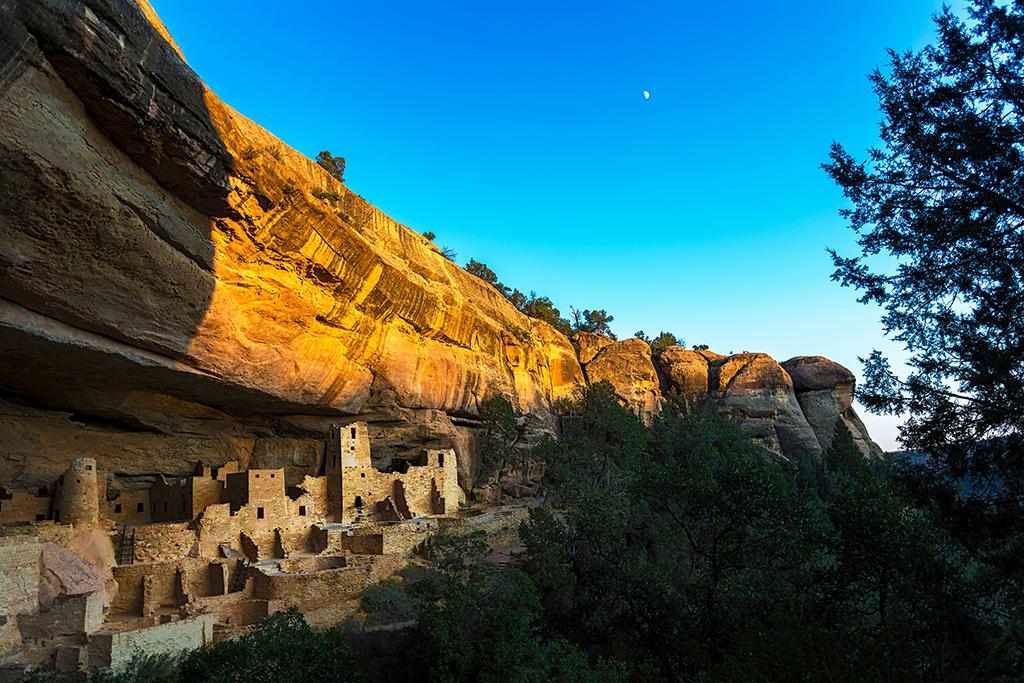
Last light on Cliff Palace, Mesa Verde National Park / Rebecca Latson
Another favorite location is Wetherill Mesa. Here, I could incorporate landscape with human habitation as I investigated Step House and took a guided backcountry hike to Mug House. I alternated between using a tripod and handholding the camera. My tripod came in handy not only for the camera, but also as a hiking stick.
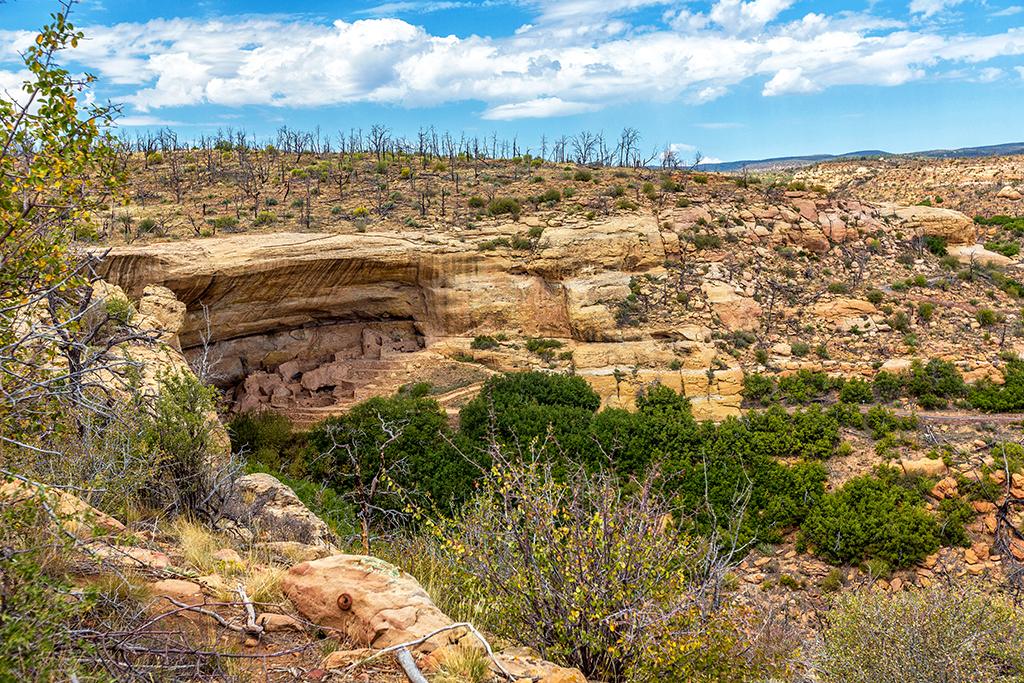
A view of Step House from the trail on Wetherill Mesa, Mesa Verde National Park / Rebecca Latson
A third favorite place is the Park Point Overlook view area. The sunrises are phenomenal at that location. For sunrises, I always used my grad ND filter because the ground area was still dark as the sun brightened the sky and I didn’t want the sun and sky to be blown out while exposing for the darker ground.
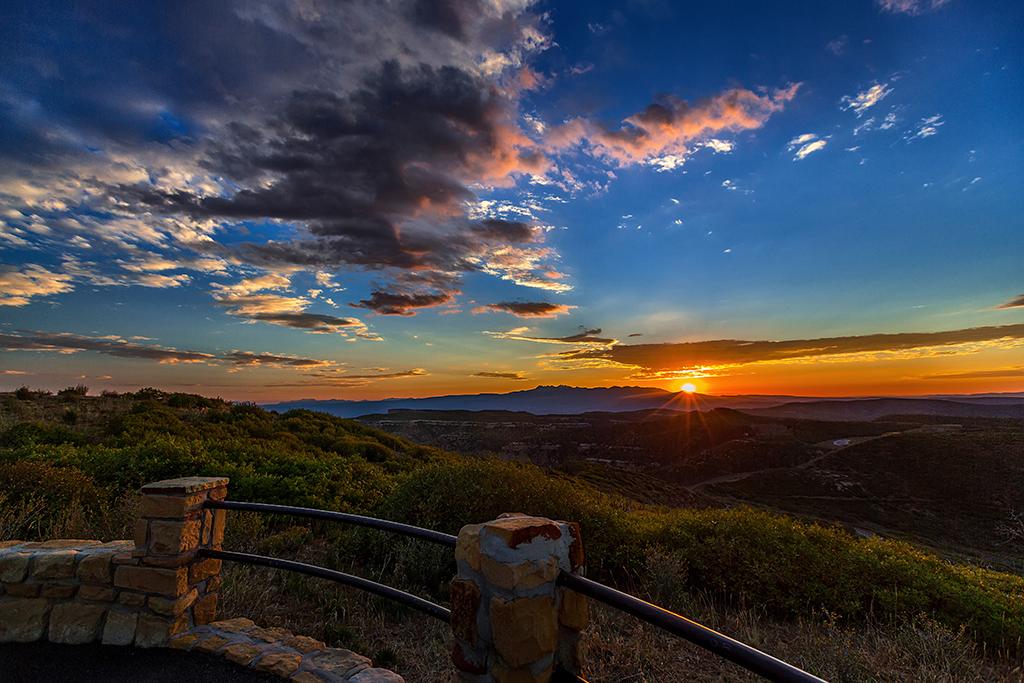
Sunrise at Park Point Overlook, Mesa Verde National Park / Rebecca Latson
There you go, my favorite photography spots for these final few national parks I’ve visited. The coronavirus pandemic has put a kink in a number of my travel plans for this year, but I'm still looking forward to discovering new favorite places for photography. Tell me, what are some favorite photo spots of national parks you’ve visited? Why are they your favorites?

Moonlight and stars over Lake Louise, Banff National Park / Rebecca Latson



Comments
Have been to most of these beautiful places. Photos are
fantastic and writeups capture the mood . Thanks for the creativity
Rebecca- Each photo told a story. Your amazing with your art of photography. Glad you got to visit each photo and sharing to others who will never get that opportunity. Glad for your girl. Will watch for more postings from you. God Bless you on your travels. I'm visual so I look for every details and you sure brought them.